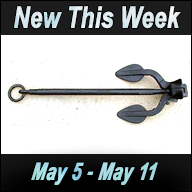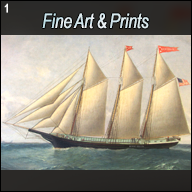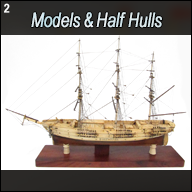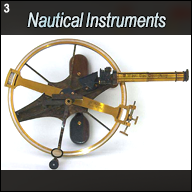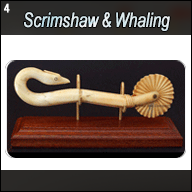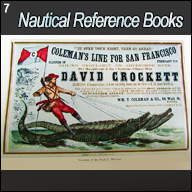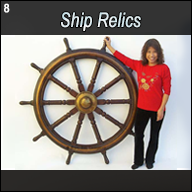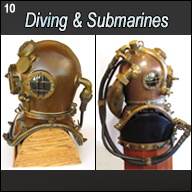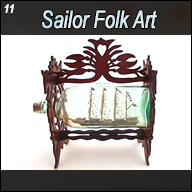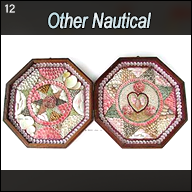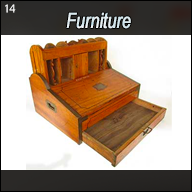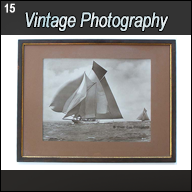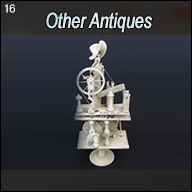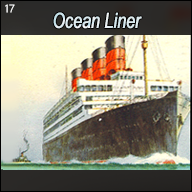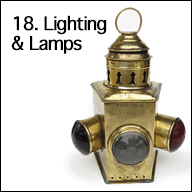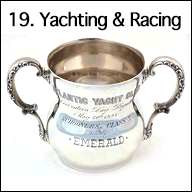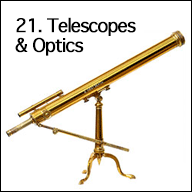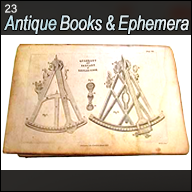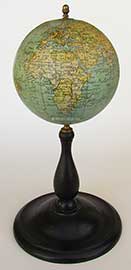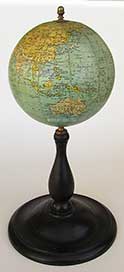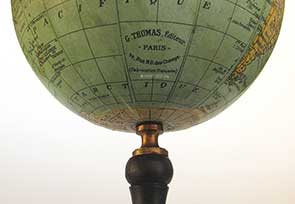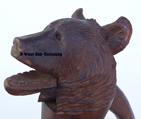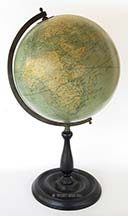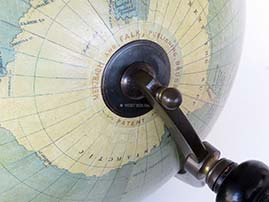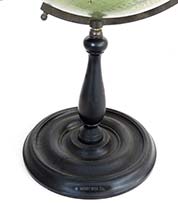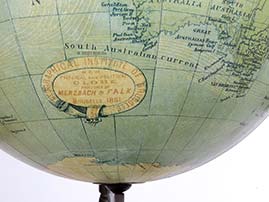16. Other Antiques
Prices in U.S. Dollars are in GREEN
 |
16.39 AMERICAN POCKET COMPASS. Turn-of-the-centurytraveler’s pocket compass constructed in 2 leaves of wood hinged together. Known as a “diptych compass,” this device has a silvered brass compass in 2 tiers. The bottom is engraved with the cardinal points of the compass with a star denoting north. It is signed “W. & L.E. Gurley Troy.N.Y.” The upper tier is marked in single degrees running counterclockwise from 0 at north to 359 marked in 10’s. The high quality compass needle has a jeweled pivot and is balanced for accuracy on the southern limb. A high quality caging device locks the needle in place automatically when the lid is closed. A “Lubbers line” is scribed in the lid for sighting. The lid fits snugly on its two hinges and is held by a small pivoting hook. 3 1/8 inches square by 1 1/8 inches thick when closed. Outstanding original condition. The compass is lively and extremely accurate. 269 W. & L.E. Gurley are perhaps the best known surveying instrument makers in American history. The Gurley name goes back as far as Ephrain Gurley who in 1813 started an iron foundry in Troy, New York. In 1851 Lewis Gurley began a partnership with his brother William. In 1852 they founded the company of W. & L. E. Gurley, not far from where their uncle Ephrain began his work. They advertised as manufacturers of compasses, theodolites, leveling instruments and “apparatus to illustrate the principles of Philosophy.” A fire destroyed their workshop in 1862, but it was quickly rebuilt that same year. Both men were active in the civic activities in their community. William Frank Gurley, son of Lewis began his work in 1882. He became a partner of W. & L.E. Gurley upon the death of his uncle in 1887. The company was incorporated under the name of “W. & L.E Gurley” on October 18, 1899. William Frank died in 1915, but the company carried on under the same name to this day. (Charles E. Smart, “The Makers of Surveying Instruments in America Since 1700,” 1962, Regal Art Press, Troy, New York). (See item 9.27) |
 |
 |
| case | dial |
 |
16.38 CANNON SUN DIAL. Especially rare, early 1800’s sun dial with the most desired feature of sounding off local noon with gun fire! This amazing device is of French manufacture, reflective of the French makers’ penchant for producing “industrial timepieces” during that era. The clever mechanism consists of a functional brass cannon mounted on a thick, solid marble plinth. The dial is deeply engraved with the hours of the solar day from 6 A.M. to 6 P.M. The triangular-shaped gnomon is fixed at the Northern apex which is engraved with the Latitude “44.50.”. When oriented to North, its shadow falls on appropriate hour of the day. Above the dial is a glass magnifying glass lens supported on turned brass arms pivoting on two brass sectors. For proper annual alignment, to compensate for the seasons, one of the sectors is engraved with the first letter of each month of the year. The marble plinth is 7 ½ inches in diameter and 1 inches thick. Overall height of the mechanism is 7 ¼ inches inclusive of the base. The cannon is 4 inches long with a bore of just over ¼ inch. Outstanding original condition in all respects showing its 200 year age. (Please read disclaimer). 2900 Known as a sundial cannon, sundial gun, noon cannon, meridian cannon and noonday gun, this device consists of a plane sun dial (also known as a “table dial”) combined with a functional cannon and fuse line. When properly oriented along its north/south axis the fuse was lit by sun’s rays concentrated by the overhead lens. Adjusting the lens to the proper elevation for the local Latitude and time of year causes it to fire at high noon. The Northern Latitude 44.50 is approximately half way between the equator and the North Pole. In North America it is about the same as the cities of Portland, Oregon; Seattle, Washington; Minneapolis, Minnesota and the border between New England and Canada. In Europe it is the same as Aquitaine, France; Venice, Italy; Bosnia and Romania. Further East it runs through Crimea; Kazakhstan; Mongolia; Jilin, China and Hokkaido, Japan. Cannon sizes of this form varied depending on their use. The household variety was used in wealthy estates to signal the time of the midday meal. Such cannons were especially popular with European royalty in the 18th century. Larger sizes were used in public parks to signal the arrival of mid-day. Cannons of this type are exhibited at the National Maritime Museum Greenwich, England. The Hamilton Watch Company of Lancaster, Pennsylvania has a sundial cannon manufactured by Rousseau of Paris about 1650. The Rousseau cannon is mounted on a marble sundial and is made of brass. The Sultan of Morocco has one manufactured by Baker & Sons of London. * * Henry Baker II, (w. 1848-1859) was a gauging instrument maker and optician in Hatton Garden. London. (Gloria Clifton, “Dictionary of British Scientific Instrument Makers 1550- 1851,” 1995, Philip Wilson Publishers, Ltd., London). Currently the only sun dial cannon in regular operation is that located in the tower of the park in Adelnoa Manor, Sweden which was installed in 1853. Its six pounder gun fires daily from May through August. |
 |
 |
| perspective | dial |
 |
 |
| cannon | magnifier |
 |
 |
| modern copy | bottom |
 |
16.36 DOMINOE SET. Genuine 19th century gaming set of 28 dominoes. This classic set is totally complete. It is made of laminated tablets of ebony and whalebone attached with brass pins. Each game piece is approximately 2 inches in length by 1 inch wide and 3/8 inches thick. They are housed in an antique faux leather-covered box adorned with a charming watercolor painting of two little girls walking hand in hand. This is an authentic painting, not a print. It is signed “L.P.” The box measures 6 ½ by 5 ¾ inches and is 1 3/8 inches thick. The box and its entire contents are in excellent original condition showing age and actual use, but no abuse or damage. 295 |
 |
| set |
 |
16.37 P.O.W. STRAWWORK BOX. Circa 1800 pocket “personals box” as made by French prisoners of war in British prisons during the Napoleonic Wars between Britain and French in the late 18th century. This classic example is beautifully made of straw of varying colors, meticulously fitted and overlaid on a stout cardboard core. The precision with which it was fabricated is unbelievable! The two oval halves join tightly together with a firm press fit. The box measures 3 5/8 inches long by 2 ½ inches wide and 1 ¼ inches thick. Condition is remarkable for a delicate object of this type over 220 years old. There are just a couple of very minor losses. Overall it must be rated at 99% complete. A great little example of the famed P.O.W. work. Included with this purchase is an original copy of the “Lloyd Collection of Napoleonic Prisoner-of-War Artifacts” illustrated catalog. 239 (See item 7.38) |
 |
 |
| reverse | open |
 |
 |
 |
| perspective | right |
 |
| back |
 |
16.34 ELEPHANT WALL DECORATIONS. Scarce, mid-century or earlier matched pair of genuine African wall hangings made from authentic materials. This set is uniquely carved from dense, solid African ebony with the elephants’ features carved from real ivory. These charming effigies portray a sense of admiration, kinship and respect that could only have been produced by the native artisans intimately familiar with their subjects. Very sturdy, solid construction measuring 5 inches tall exclusive of the hanging rings and 5 3/8 inches wide inclusive of the tusks. Dense, very heavy. Excellent original condition. Guaranteed to be of the period. 349/pr This pair was undoubtedly carved by forward looking African tribes who experienced an ever increasing tourist trade from the Western world in the early 1900’s. The materials used were indigenous and the workmanship was native. The manufacture of this rare pair far predates worldwide concerns of both the African elephant species and the equally scarce rich tropical hardwoods from the region. Thankfully, efforts and laws are now in place to protect both. As such, this is a rare opportunity to acquire authentic antique tribal artworks made long before the modern ban. Not available or for sale in California. Shipped from Massachusetts. |
 |
 |
| perspective | detail |
 |
| back |
 |
 |
 |
| cartouch | california |
 |
 |
 |
| top detail | bottom detail |
 |
 |
| back | eagle |
 |
16.28 SNUFF BOX. Exquisite early 1800's personal box carved from horn with an unusual hinged lid. The unique hinge is actually carved top and bottom out of contiguous material. There is no metal. The hinge is part of the box! The body of the lid is also carved from horn with a layer of decorative tortoise shell laminated on top. Crowning the presentation is a very delicate and elaborate inlay of silver wire with an oval cartouche. The workmanship lavished on this piece is of exceptional quality. We have never seen better! 349 |
 |
 |
| perspective | open |
 |
| bottom |

|
16.25 EARLY "BLACK GLASS" BOTTLE. Genuine "black glass" wine bottle from the 1700's. This hand-blown vessel is surprisingly heavy with telltale swirling surfaces and indented blown "pontil" on the bottom. The glass is nearly opaque but bright light as from the sun can be seen passing through it. 8 ¼ inches tall by 2 ¾ inches in diameter. Excellent condition with no flaws. Our research indicates this type of bottle was made from 1770 to 1800. SOLD |

|
16.26 MINIATURE ANTIQUE BOTTLE. Charming brown glass bottle standing a mere 4 ¾ inches tall by 1 ¼ inches in diameter. This molded bottle is made of very thick irregular glass and dates from the Civil War era or earlier. SOLD |
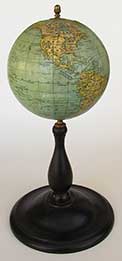
|
16.24 19th CENTURY GLOBE. Authentic second half of the 1800's terrestrial globe of French manufacture. The globe is signed in the South Pacific "G. THOMAS Éditeur =PARIS= 44, Rue N.-D. (Fabrication Francaise)." This 5 inch variety world globe was made in the traditional way with a plaster core overlaid by 12 chromolithographed paper gores. The quality and detail for a globe of this size is really amazing. The globe is supported on its original ebonized turned wooden stand with brass fittings. 11 ¾ inches tall by 6 inches in diameter on the base. Outstanding original condition. An absolute "gem" for desk, library or display shelf! 895 |
north america |
africa |
asia |
maker |

|
16.23 FERRY BOAT TOKEN. Genuine early 1900's token for transportation in the San Francisco Bay Area. This solid brass coin-like token is about the size of a dime (10 cent piece). It is nicely minted with the obverse reading "MUNICIPAL RAILWAY" on a "spider web" background with the center prominently cut-out "SF." The reverse, in the same, format reads "ONE FARE • SAN FRANCISCO." Excellent original condition. 8.50 Price includes First Class mail service in U.S. |
reverse |
16.17 NUT CRACKER. Charming late 19th C. hand-carved German nutcracker of Black Forest origin. This cleverly contrived and beautifully executed device is in the form of a realistic bear with inset "bean" eyes. The bear's mouth effectively cracks smaller nuts whereas a carved recess at the rear, under the lever, accommodates larger nuts such as walnuts. This intricate, two piece carving is made from a dense dark hardwood, probably walnut. Detailing is very realistic. Excellent original condition with no chips or cracks and a lovely age patina. 7 inches long. 250 |
perspective |
detail |
front |

|
16.16 AMERICAN TELLURIUM. Extremely rare 4th quarter of the 19th century American planetary model by “A.H. ANDREWS & CO. CHICAGO” as signed in relief on the ornately decorated cast support arm. It is additionally signed in the maker’s cartouche located in the northwestern Pacific, “A. ANDREWS 8 Inch TERRESTRIAL GLOBE with the latest discoveries and ocean currents A. H. Andrews & Co. Chicago.” This amazing apparatus depicts the earth revolving about the sun in the center of the weighted stand with a proportional radial sector of the sun in brass indicating serrated “flames.” Between the sun and the earth is a moveable rod on which a wooden orb representing the moon is attached. These ride on a pedestal atop a very heavy cast iron base which is encircled with the 12 signs of the Zodiac. Each of the 12 quadrants is charmingly decorated with an image of the mythological sign, the month, the degrees from North and the points of the compass. These lithographed images are somewhat faded with time, but still very colorful and legible. Attached to the swinging support arm opposite the earth is an arrow which indicates the earth’s position on the Zodiac as it orbits the sun. The earth is represented by a globe made in the traditional manner with a plaster sphere overlaid by 12 lithographed gores. The detail of the geography is of a very high standard with multi-color countries and major cities shown. As the name implies, ocean and atmospheric currents are notable as is the declination line of the sun between the 2 solstices. The condition of the globe is excellent and original with no damage of repairs, noting good age toning to its protective varnish. The North Pole is fitted with a moveable brass arrow to highlight a specific Meridian or geographical feature. Surround the globe is a heavy brass cage mounted to the support arm. It has two Meridian Circles and one Equatorial circle connected to a removable swan’s neck support on the arm Construction and materials throughout are of the highest order! 21 ½ inches wide and 16 ½ inches tall overall. The base measures 12 inches in diameter. The entire apparatus weighs 13 pounds. Price Request |
detail |
reverse |
asia |
base |
maker |
signature |

|
16.15 WORLD WAR I GOGGLES. Very rare surviving pilot’s or motorcyclist’s goggles dating to or before World War I. This cloth and leather pair consists of 4 glass panels held in metal frames. Indicative of their early manufacture the glass is not curved, but has wrap around sides. The top and bottom have small breather holes within metal grommets. The goggles themselves are 9 inches wide with the cloth straps extending to 36 inches in width overall. These goggles are in frail condition evidencing some hand-stitched repairs. That noted, the glass panels are in excellent original condition. These very scarce early goggles make a great statement as a genuine testament to a bygone age over 100 years ago! 59 |
detail |
back |

|
16.14 ANCIENT JAPANESE HAND MIRROR. Mid-19th century nickeled bronze dressing mirror of Japanese origin. The “working side” of this early-form mirror is in a high polish which remarkably still provides a highly reflective image. The reverse is richly decorated in incredibly detailed relief depicting a turtle at the center facing two kissing cranes. Below is their brood of 3 chicks. The background is made up of pine bows and bamboo, set within 2 concentric circles. On the outer edge are more decorative floral designs. This unique piece is signed with a 4 character mark beginning with “da” meaning large or grand. Interestingly the turtle’s shell is rove through with a hole for attaching a thong. 5 inches in diameter, ¾ of and inch think and weighing 2 pounds. 289 |
detail |
mirror |

|
16.13 CANNON CIGARETTE LIGHTER. Very early 1900’s American cigarette/cigar lighter in the form of a pre-World War I artillery cannon. Made in U.S.A. by "Negbaur, NY." as signed on the bottom of the lighter. It measures 8 inches long and is 3 inches wide. The spoked carriage wheels actually turn. It is made of a heavy non-ferrous metal, either pewter or brass. The lighter is completely functional. The finish details are superb. 295 |
reverse |
barrel |
carraige detail |
lighter |
lighter detail |
maker |

|
16.12 RARE GERMAN TERRESTRIAL GLOBE. An exceptional world globe by Germany’s preeminent 19th century cartographer Ludwig Heymann as indicated (in part) on the maker’s cartouche in the Pacific Ocean just above the Sandwich Islands, “ERD-GLOBUS.
Ludwig Julius Heymann (1836-1899) began the production of globes in 1883. Ref. “Globes From The Western World,” 1993, Elly Dekker and Peter van der Kroght, Trevor Philips & Sons, London. |
reverse |
north pole |
pedistal |
compass |

|
16.10 CARVED AMERICAN EAGLE. Genuine late 19th century carving of a patriotic American eagle in the style of John Hayley Bellamy. It is carved of pine using the sure, precise strokes of a professional wood carver. It is of classic two-piece carved pine construction with the head and body screwed onto the backboard which also serves as the wings. The eagle carries a flagpole which once waived a wooden banner, again in the Bellamy tradition. The banner is missing. This antique carving retains its old genuine gilded surfaces on the front with good telltale oxidation of the bare wood and old iron fasteners on the back. The carving measures 24 inches wide by 5 inches high and is 2 7/8 inches deep. If this carving could be attributed to Bellamy, we would conservatively adjudge its value to be $12,000. We are not asserting it is Bellamy, but we definitely assure it is from the same late 19th century period. It is certainly equal to Bellamy’s work at a fraction of the price his works demand for such a carving. Was 1495 NOW 895! |
detail |
back |
back detail |
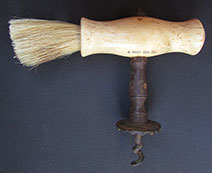
|
16.66 EARLY CORK SCREW. Very old, wine cork screw of French manufacture. This oenophilic tool has a sculpted bone handle with a tufted bristle brush on one side and a turned bone cap on the other. The working end is a cast iron cork screw with radiating circular top, the entire assembly of which is rove through the bone, held by a very old style circular nut. The width of the bone handle is 3 ¾ inches. With brush is measures 4 ¾ inches wide and 4 inches to the tip of the corkscrew to the top of the handle. Overall condition is excellent, however the tip of the screw was broken off by an enthusiastic wine bibber. Priced accordingly. 149 |
ex. Paul Madden Antiques, Sandwich, Massachusetts.
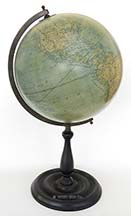
|
detail |
north america |
europe - africa |
north pole |
south pole |
pedestal |
maker |
base |

|
16.02 P.O.W SPINNING JENNY. Authentic late 18th century or very early 19th century automaton known as a “spinning jenny,” made by the gifted French prisoners detained in British prisons during the Napoleonic War era, from 1775 through 1806. Characteristic of these marvelous whimsies, this example is made entirely of beef bone. It features a woman in a period bustle dress with huge bonnet sitting at her spinning wheel. This elaborate presentation has 2 tiers connected by finely-turned bone columns. The top tier shows the lady at her wheel sitting in a fancy chair with two decoratively-carved bone columns, a windmill and a rotating spool for taking up the yarn. Below is the “engineroom” of this automaton with its two cogged wheels operated by a hand-crank and an ingenious mechanical movement which provides realistic movement to the figure above. When rotating the hand crank the spinning wheel turns, the lady lifts her arm and turns her head. At the same time the windmill revolves. All of this is mounted to a single turned bone pedestal on a circular base. This genuine old example is in an amazing state of original preservation, with no repairs and no damage, and is in working condition. 5 ½ inches high, 2 3/8 inches wide and 2 5/8 inches front to back inclusive of the crank. 1475 An elaborate P.O.W. spinning Jenny was sold by the Skinner Auctions on March 4, 2012. While it was not functional, it contained many interesting elements which exceeded the complexity of this offering. 7 x 5 x 3 inches. Nevertheless, it sold for $16,590. Disclaimer: We certify this object is in original condition and functioning as it was originally constructed, as shipped by us. However, being over 200 years old and obviously fragile, we cannot guarantee its sustained performance. Our recommendation is that its use be kept to a minimum and enjoyed for the delight to the eye it is… much like collectors of fine antique watches and clocks keep their valued possessions in non-running status. |
perspective |
detail |
side |
back |

|
DETAIL |
SUPER DETAIL |
BACK |
BAROMETER |
16.56 EARLY LIVERPOOL JUG. Genuine late 18th century creamware "Herculaneum" pitcher. This lovely old example bears 3 distinctive transfers. The obverse is decorated with the delightfully endearing scene of a pub owner offering a mug to a willing recipient restrained by his wife. The comedic caption reads, "Come come my old buck here's the liquor of LIFE. Which drives away sorrow and reconciles strife. It cures scolding women. Your wrong reply'd Nell. Your wife as a drunken scold does most excel." The reverse shows a surprisingly detailed map of the earth surrounded by classical figures including Lady Britannia and a sunburst. It is entitled "The World in Planisphere." Under the spout is the poem, "Succefs To the Plough. The Fleece and the Pail. May the Landlord Ever Flourish. And the Tenant Never fail." It is surrounded by vignettes depicting farm implements. This wonderful example of early English pottery measures 10 inches high and 9 3/4 inches across from spout to handle. The graceful handle is noteworthy in that it is particularly stout and has contoured edges. There is a tiny professional repair to the very tip of the spout and as expected there are a couple of minor hairlines in the bottom. Overall this jug must be rated as being in outstanding original condition. Circa 1790. Price Request Telling of the age of this jug, the spelling of the word "Succefs" is with the early form f as an "s." Further, the world map of North America shows a blank Pacific Northwest, indicating it was yet unexplored. |

|
16.88 IMPORTANT CANDLEABRAS. Exquisite matched set of early 1800’s French ormolu and gilt bronze candelabras mountedatop heavy alabaster pedestals. Each candleholder set is comprised of 5 radiating cups with another cup mounted higher in the center. Each cup is ornately decorated with floral motifs and sprays. The multifunctional center cup is designed to hold a sixth candle or serve as a crowning finial in the form of an ornate floral bouquet. Each candelabrum is supported by a seated puti holding these large torches. The gilded bronze pedestals on which they are seated are mounted atop solid alabaster columns bound in bronze set on heavy tripod floral bases with acanthus leaf embellishments. The underside of each base contains a wooden insert secured with a square nut. Evidencing their age the wood exhibits some old telltale worm holes – a good sign of 19th century French exposure. Each presentation stands 22 inches tall overall and 10 ½ wide at the widest. The bases measure 6 ½ inches wide. Outstanding original condition with untouched surfaces. A remarkable set worthy of the finest home or institution. Price Request |
holders |
cup detail |
final detail |
base |
puti |
puti detail |
bottom |

